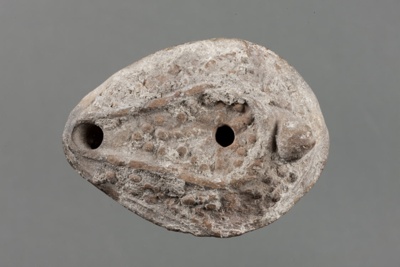< Collection search
< Collection highlights
From:UC Teece Museum of Classical Antiquities
Name/TitleLamp
About this objectThis object is typical of lamps manufactured in the eastern Mediterranean region in Late Antiquity. The shape began in the Byzantine period and continued well after the spread of Islam in the seventh and eighth centuries.
The oil chamber is piriform (pear-shaped), usually with a sharp carination (concave join) between the upper and lower halves. A conical handle is placed at the back and a ridge extends from the handle to around the wick hole, defining a flattened or slightly concave area around a small filling hole. Simple decorative elements are usually placed both on the shoulder and around the filling hole.
This is one of a series of lamps that were manufactured in what is now Lebanon. Many have been found in Sidon (also known as Sayda or Saida) and Tyre. Lamps of this type have a piriform ring base and a coating of red slip, (both of which are found on this example). They were often made with simple decorative elements, such as animals, floral scrolls, crosses, wavy lines, geometric patterns, raised dots, and spirals. The decoration here consists of a simple raised dot pattern, which is hard to see due to the worn surface and heavy incrustation. The pattern may represent simple clusters of grapes, as seen on slightly different lamps found at Sidon and el Bassa.
Date Made6th-7th Century CE
PeriodLate Antique
Place MadeSyria
Medium and MaterialsCeramic: Pottery
TechniqueMolding (forming)
MeasurementsLength 89mm; Width 70mm; Height (including lug) 36mm
Subject and Association KeywordsFood in art
Subject and Association KeywordsNature in art
Named CollectionThe James Logie Memorial Collection, University of Canterbury, New Zealand
Object TypeLamp
Object number194.04
Copyright LicenceAll rights reserved
